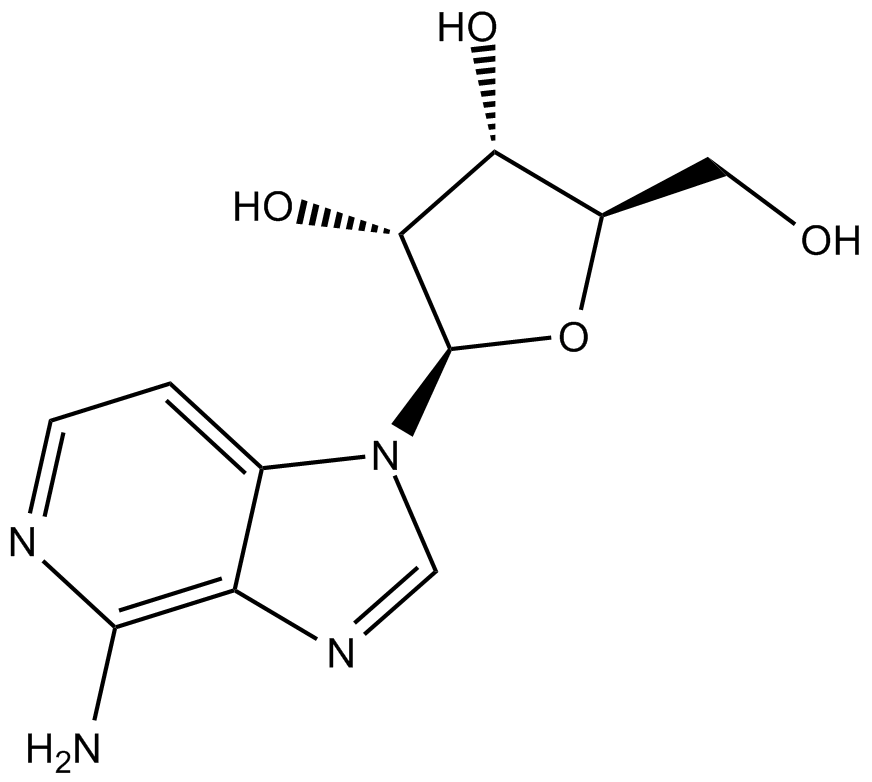3-Deazaadenosine (Synonyms: c3Ado, deazaAdo, 3-DZA) |
| Catalog No.GC14713 |
3-Deazaadenosine (hydrochloride) is an inhibitor of S-adenosylhomocysteine hydrolase, with a Ki of 3.
Products are for research use only. Not for human use. We do not sell to patients.

Cas No.: 6736-58-9
Sample solution is provided at 25 µL, 10mM.
3-Deazaadenosine (hydrochloride) is an inhibitor of S-adenosylhomocysteine hydrolase, with a Ki of 3.9 µM[1].
3-Deazaadenosine dose-dependently prevented the proliferation and migration of human coronary VSMCs in vitro. This was accompanied by an increased expression of the cyclin-dependent kinase inhibitors p21(WAF1/Cip1), p27(Kip1), a decreased expression of G(1)/S phase cyclins, and a lack of retinoblastoma protein hyperphosphorylation. [3]. In the mouse macrophage cell line, RAW264. S-Adenosylhomocysteine accumulated in cells incubated with 3-deazaaristeromycin while S-3-deazaadenosylhomocysteine was the major product in cells incubated with 3-Deazaadenosine and homocysteine thiolactone[4].200 microM 3-Deazaadenosine (c3Ado) prevented this TNF-induced increase in HEC adhesiveness. This effect resulted from interactions of 3-Deazaadenosine with HEC and not with polymorphonuclear neutrophils[5]. 3-Deazaadenosine (DZA), an adenosine analogue, prevented high methionine-induced ICAM-1 and VCAM-1 expression and collagen type-1 synthesis.in vitro 3-Deazaadenosine and CBS gene therapy successfully treated the HHcy-induced inflammatory reaction in the methionine metabolism pathway[6].
3-Deazaadenosine (c3Ado) inhibits atherogenesis in mice. Sprague Dawley rats underwent balloon angioplasty. 3-Deazaadenosine was administered orally, starting 5 days prior to the balloon injury and continued for 2 weeks. Fourteen days after balloon injury the intima/media ratio in the c3Ado-treated group was reduced by 67% and luminal stenosis by 50%. Neointimal cellular density was decreased by 25% and the induction of c-Jun and ki67 was markedly lower. Short-term administration of C3Ado inhibits neointima-formation in rats for at least 3 months after injury[7].
References:
[1]: Gordon RK, Ginalski K, et,al. Anti-HIV-1 activity of 3-deaza-adenosine analogs. Inhibition of S-adenosylhomocysteine hydrolase and nucleotide congeners. Eur J Biochem. 2003 Sep;270(17):3507-17. doi: 10.1046/j.1432-1033.2003.03726.x. PMID: 12919315.
[2]: Jeong SY, Ahn SG, et,al. 3-deazaadenosine, a S-adenosylhomocysteine hydrolase inhibitor, has dual effects on NF-kappaB regulation. Inhibition of NF-kappaB transcriptional activity and promotion of IkappaBalpha degradation. J Biol Chem. 1999 Jul 2;274(27):18981-8. doi: 10.1074/jbc.274.27.18981. PMID: 10383397.
[3]: Sedding DG, TrÖbs M, et,al. 3-Deazaadenosine prevents smooth muscle cell proliferation and neointima formation by interfering with Ras signaling. Circ Res. 2009 May 22;104(10):1192-200. doi: 10.1161/CIRCRESAHA.109.194357. Epub 2009 Apr 16. PMID: 19372464.
[4]: Backlund PS Jr, Carotti D, et,al. Effects of the S-adenosylhomocysteine hydrolase inhibitors 3-deazaadenosine and 3-deazaaristeromycin on RNA methylation and synthesis. Eur J Biochem. 1986 Oct 15;160(2):245-51. doi: 10.1111/j.1432-1033.1986.tb09963.x. PMID: 3769925.
[5]: Jurgensen CH, Huber BE, et,al. 3-deazaadenosine inhibits leukocyte adhesion and ICAM-1 biosynthesis in tumor necrosis factor-stimulated human endothelial cells. J Immunol. 1990 Jan 15;144(2):653-61. PMID: 1967270.
[6]: Sen U, Tyagi N, et,al. Cystathionine-beta-synthase gene transfer and 3-deazaadenosine ameliorate inflammatory response in endothelial cells. Am J Physiol Cell Physiol. 2007 Dec;293(6):C1779-87. doi: 10.1152/ajpcell.00207.2007. Epub 2007 Sep 13. PMID: 17855772.
[7]: Seeger FH, Hess W, et,al. The nucleotide analogue 3-deazaadenosine prevents neointima-formation after balloon injury. Biochem Biophys Res Commun. 2009 Jan 23;378(4):826-31. doi: 10.1016/j.bbrc.2008.11.151. Epub 2008 Dec 12. PMID: 19070587.
Average Rating: 5 (Based on Reviews and 2 reference(s) in Google Scholar.)
GLPBIO products are for RESEARCH USE ONLY. Please make sure your review or question is research based.
Required fields are marked with *




















